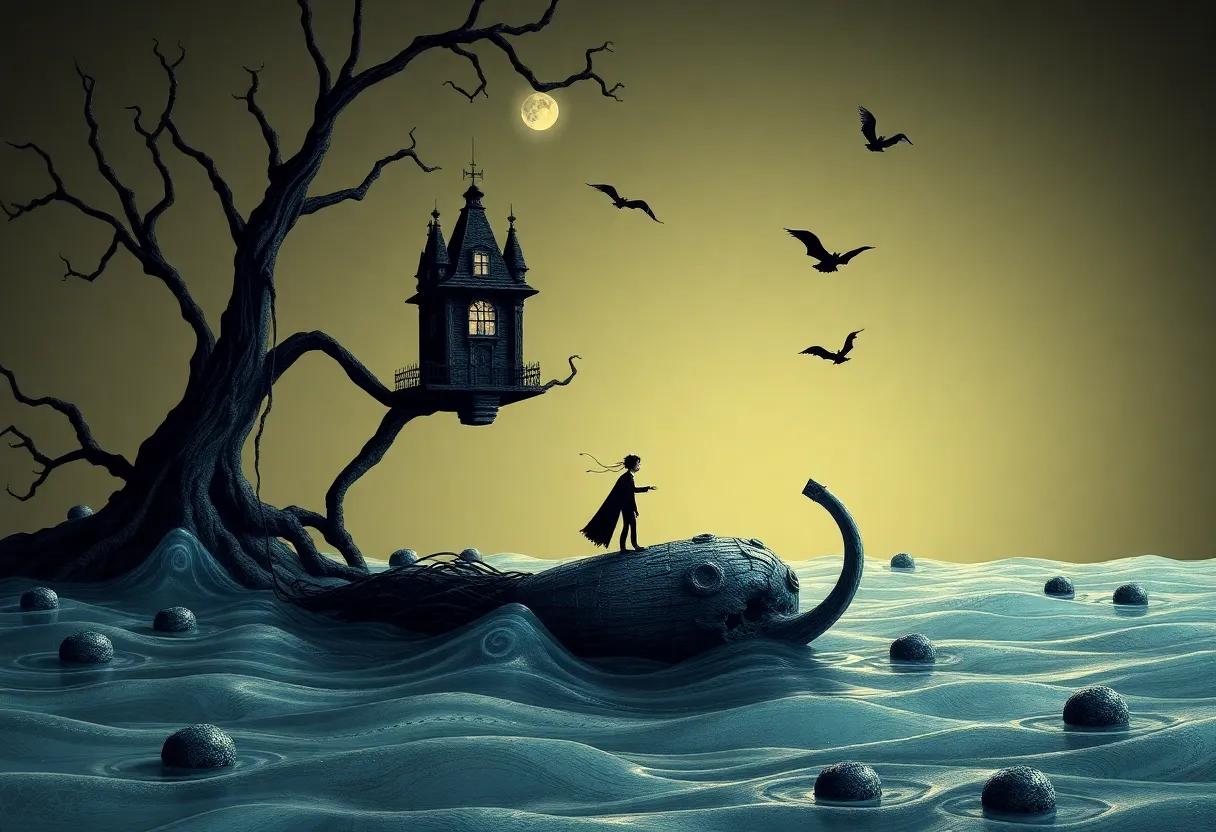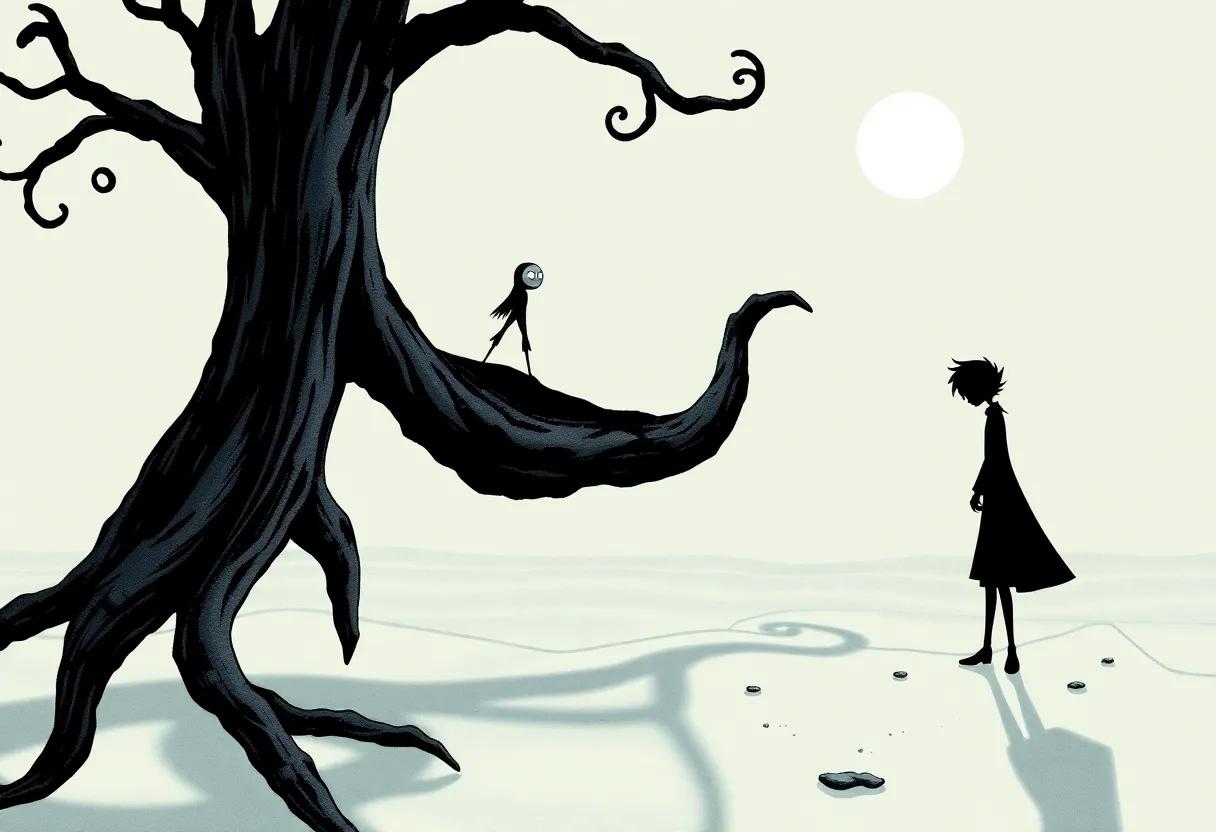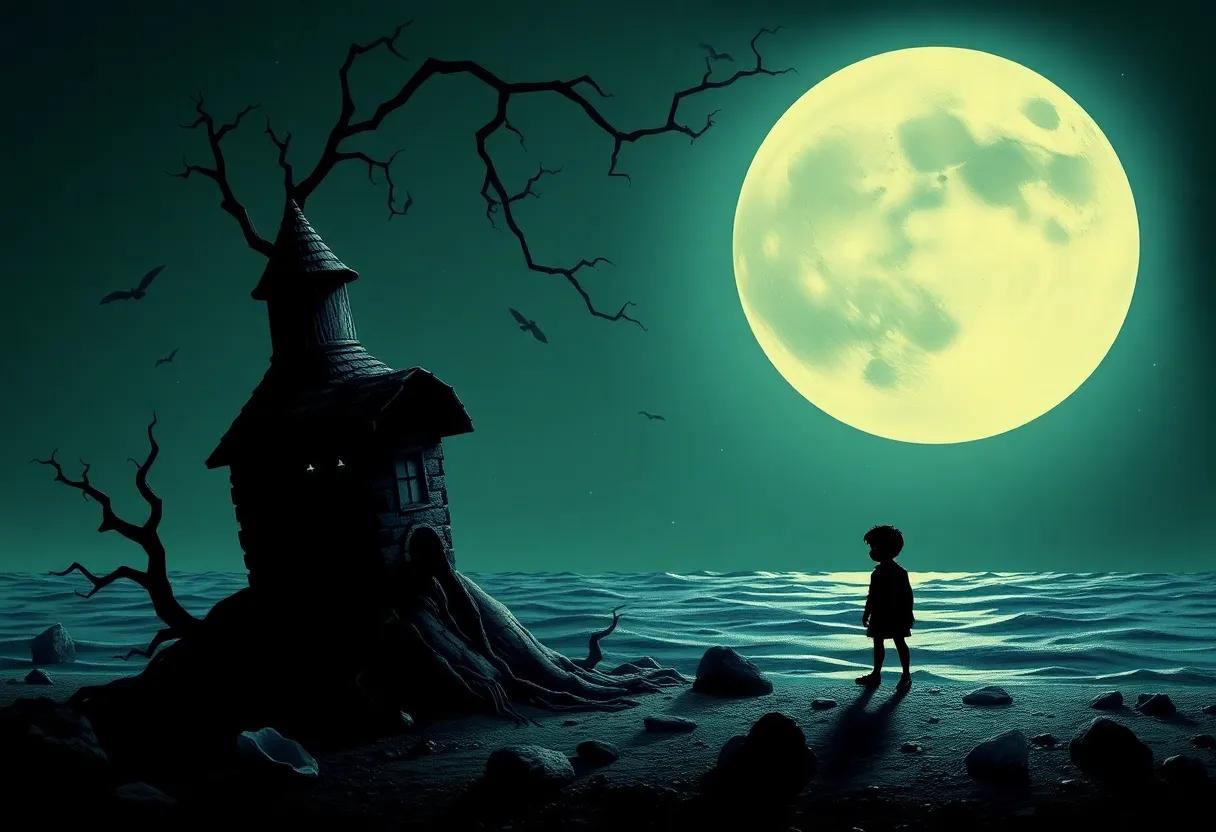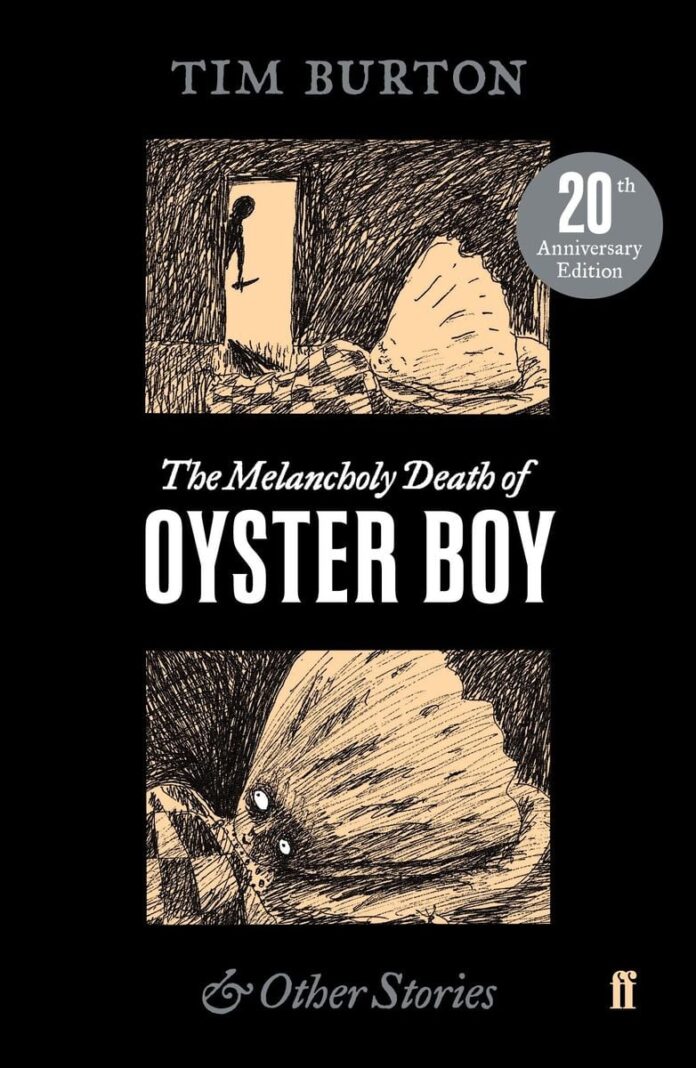In the shadowy intersection where the eerie meets the whimsical, Tim Burton’s The Melancholy Death of Oyster Boy carves out a singular space that both enchants and unsettles. This collection of darkly imaginative poems and illustrations invites readers into a world peopled by peculiar characters-each marked by a haunting blend of vulnerability and oddity. As a reflection of Burton’s signature style, the book oscillates between melancholy and whimsy, challenging conventional notions of childhood, loneliness, and acceptance. In this review, we delve into how Burton’s unique artistic vision shapes the narrative, examining the delicate balance he strikes between the macabre and the charming.
Exploring the Unique Blend of Dark Fantasy and Whimsy in The Melancholy Death of Oyster Boy

Tim Burton’s The Melancholy Death of Oyster Boy masterfully intertwines the unsettling shadows of dark fantasy with an innocent, childlike whimsy that both captivates and disturbs. Each poem and illustration feels like a glimpse into a bygone carnival where the macabre dances hand-in-hand with the surreal.Burton’s characters-quirky, tragic, and bizarre-invite readers to explore a world where oddities become protagonists and where vulnerability enhances their eerie charm. This delicate balance between darkness and playfulness encourages an emotional connection that transcends the grotesque, revealing a strangely comforting humanity beneath each twisted tale.
The fusion of moody atmospherics with whimsical storytelling is further accentuated by recurring themes and motifs. discover how elements work together to evoke this unique blend:
- Visual Contrast: stark black-and-white sketches juxtaposed with whimsical, childlike innocence
- Character Oddities: outcasts and misfits portrayed with empathy and dark humor
- Poetic Structure: simple rhyme schemes that mask complex, frequently enough tragic narratives
| Element | Dark Fantasy feature | Whimsical Twist |
|---|---|---|
| Characters | Monstrous hybrids | Childlike innocence |
| Setting | Gothic, eerie landscapes | Playground imagination |
| Tone | Melancholy, tragic | Humorous, light-hearted |
Analyzing Tim Burton’s visual Storytelling Through Vivid Character Illustrations and Gothic Aesthetics

Tim Burton’s mastery lies in crafting characters that are both haunting and endearing-creatures who oscillate between grotesque and whimsical with effortless charm. In The Melancholy Death of Oyster Boy, these vivid illustrations breathe life into oddly shaped figures brimming with emotion and depth. His distinct use of exaggerated features, from oversized heads to elongated limbs, serves not only as a visual hook but also as a window into the souls of these outcasts. Each character, whether sorrowful or sinister, invites viewers into a world where imperfections become the very essence of identity, reflecting Burton’s delicate balance between darkness and innocence.
The unmistakable Gothic aesthetic provides a rich visual framework that intensifies the melancholic atmosphere.Stark contrasts of black and white, shadow-drenched scenes, and intricate patterns combine to evoke a timeless, fairy-tale-like quality. Key elements that define this style include:
- Twisted architecture: spires, arches, and cobwebbed corners evoke mystery and isolation.
- Moody textures: weathered surfaces and delicate lace create a tactile sense of decay and beauty.
- Symbolic motifs: bats, skulls, and wilted roses emphasize themes of mortality and lost innocence.
| Visual Element | Effect |
|---|---|
| Monochrome palette | Heightens emotional contrast |
| Elongated figures | Express vulnerability and alienation |
| Occasional vibrant hues | Draws focus to emotional peaks |
Thematic Depth Beneath the Macabre Humor: Childhood isolation and Identity in Burton’s Poems

Tim Burton’s poems are often likened to quirky caricatures of childhood traumas, painted with strokes of dark humor and surreal imagery. Beneath the twisted tales and macabre wit lies a poignant exploration of isolation and the fragile search for identity. Characters like the oyster Boy and Staring Girl navigate worlds that alienate them, their oddities symbolizing the universal experience of feeling out of place during formative years. Each poem becomes a mirror reflecting the deep ache of not just being different but misunderstood, blurring the line between whimsy and melancholy with exquisite precision.
Burton’s unique confluence of grotesque fantasy and raw emotion invites readers into a secluded realm where childhood fears and desires coexist in gorgeous disarray. the thematic motifs that surface repeatedly include:
- Loneliness as a defining trait-characters trapped in self-imposed or societal exile.
- The struggle between self-acceptance and external rejection.
- Death not as an end, but as a metaphor for transformation and transcendence.
These poems, deceptively simple on the surface, leverage dark whimsy to probe how identity can be both fractured and fiercely individualistic, inviting introspection on what it means to belong-or not belong-at any age.
| Character | Symbolism | Thematic Element |
|---|---|---|
| oyster Boy | Fragility & Isolation | Feeling misunderstood |
| Staring Girl | Alienation & Gaze | Self-consciousness in identity |
| Robot Boy | Machine vs. Human | Searching for acceptance |
How Quirky Tragedy Shapes Emotional Resonance in These Eccentric, Endearing Vignettes

at the heart of these miniature tales lies a delicate interplay between whimsy and despair,a dance that gives each character a profound emotional depth despite their odd appearances. The tragic elements are never blunt or overwhelming; rather, they are subtly woven into the narrative fabric, lending a bittersweet charm to the quirky protagonists.Their eccentricities aren’t just for shock or humor-they serve as poignant metaphors for isolation, longing, and the universal human experience of feeling out of place. This unique fusion creates an emotional resonance that invites readers to empathize with the characters’ silent struggles,making their bizarre world strangely relatable.
Several recurring themes amplify this emotional layering, including:
- Alienation: Characters often grapple with being rejected or misunderstood by society.
- Innocence lost: Many vignettes highlight the fragile nature of innocence amid a harsh world.
- Strange beauty: the surreal visuals and odd traits symbolize hidden depth beyond exterior oddities.
| Character | Quirk | Underlying Tragedy |
|---|---|---|
| Oyster Boy | Always crying pearls | Unseen sorrow despite shiny exterior |
| robot Boy | Mechanical body, human heart | Yearns for genuine connection |
| Baby Fish | Fish head on baby body | Struggles for acceptance |
The Role of Minimalist Typography and Layout in Enhancing the Book’s Haunting Atmosphere
Tim Burton’s The Melancholy Death of Oyster Boy thrives on an eerie blend of whimsy and sorrow, a balance artfully preserved through its stripped-back typographic and layout choices. Rather than overwhelming the reader with elaborate flourishes, the minimalist typography creates a stark contrast that mirrors the loneliness and peculiarity of each character.The sparse use of fonts, often uniform and unadorned, guides the eye gently, allowing the unsettling narratives and macabre illustrations to take center stage. This intentional simplicity evokes a quiet unease, where white space becomes a breathing room for the haunting undertones to seep in, heightening the emotional impact one line at a time.
The layout further amplifies this effect by embracing asymmetry and unpredictable spacing, aligning with Burton’s signature off-kilter world. Key elements that contribute include:
- Unvaried font sizes that create monotony, mimicking the monotone voices of his tragic characters.
- Generous margins and line-height that simulate isolation within the page,almost as if each poem stands alone in the void.
- Strategic placement of text opposite eerily spaced illustrations, fostering tension between emptiness and presence.
| Design Element | Atmospheric Effect |
|---|---|
| Monochrome Typography | Emphasizes loneliness and bleakness |
| Whitespace | Heightens suspense and emotional distance |
| asymmetrical Alignment | Reflects the quirky, unsettled tone |
Comparing The Melancholy Death of Oyster Boy to Tim Burton’s Cinematic Works for Fans and Newcomers
While Tim Burton’s cinematic universe is famously rich with gothic visuals and eccentric characters, The Melancholy Death of Oyster Boy delves into his darker daydreams through an intimate collection of poems and illustrations. Unlike his films,which often weave melancholy with fantasy in sprawling narratives,this book condenses his signature quirks into brief,poignant snapshots of tragically odd children. Both mediums embrace themes of isolation, misfit identities, and whimsical morbidity, yet the book offers a rawer, more concentrated glimpse into the imagination that colors his big-screen creations.
for fans familiar with Burton’s films like Edward Scissorhands or Beetlejuice, the book feels like meeting the same soul carried on whispers-more haunting, less humorous. Newcomers will find an accessible entry point where the delicate balance between charm and sadness is beautifully undiluted. Here’s a simple comparison to highlight these nuances:
| Aspect | Tim Burton Films | The melancholy Death of Oyster Boy |
|---|---|---|
| Format | Feature-length films | Poetry & Illustrations |
| Tone | Gothic whimsy with humor | Dark whimsy with poignancy |
| Characterization | Detailed, developed arcs | Brief, archetypal portraits |
| Audience Experience | Immersive visual storytelling | Concise emotional snapshots |
- Visual Style: Both share Burton’s iconic hand-drawn aesthetics, but the book’s sketches are more stripped-down and intimate.
- Emotional Depth: Films explore complex relationships broadly, while the poems focus intensely on singular moments of longing and oddity.
- Accessibility: The book’s short,standalone pieces allow readers to dip in and out,making it ideal for those new to Burton’s universe.
Why This Collection Appeals to Readers Who Appreciate Dark Fairy Tales with a Twist of Satire
The allure of this collection lies in its masterful fusion of eerie fairy tale aesthetics with sharp, sardonic humor. Tim Burton’s distinct narrative voice transforms conventional archetypes into peculiar characters who live on the bleak edge of childhood nightmares and whimsical absurdity.The stories invite readers to embrace the unsettling yet captivating world of misfits and outcasts – creatures who symbolize vulnerability, alienation, and dark curiosity. This blend creates an emotional resonance that appeals to those who seek not only enchantment but also a profound commentary on human folly and societal quirks.
What makes these tales especially compelling is their ability to balance macabre imagery with a playful subversion of expectations. Satire sneaks in through witty juxtapositions and ironic twists that challenge the reader’s perception of morality and innocence. The collection’s charm can be broken down into key elements that continuously engage its audience:
- Unconventional protagonists: Embracing the weird and imperfect as heroes of their stories.
- Dark humor: Injecting laughter into morbid situations to lighten the mood without losing depth.
- Visual storytelling: Distinctive illustrations that complement and enhance the eerie tone.
- Layered meanings: Stories that operate both as gothic fables and social critique.
| Element | Effect |
|---|---|
| Macabre Characters | Evokes empathy through grotesque charm. |
| Satirical Tone | Offers reflective humor and social insight. |
| Poignant Irony | Challenges traditional moral lessons. |
| Visual Artistry | Creates an immersive, whimsical atmosphere. |
The Influence of surrealism and Pop Culture on Burton’s crafting of Morbidly Charming Characters
Tim Burton’s characters often inhabit the twilight zone between the whimsical and the grotesque, a duality heavily inspired by the surrealist movement. This artistic approach allows Burton to mold figures that resonate with both charm and unease, echoing Salvador Dalí’s dreamlike distortions and René magritte’s enigmatic juxtapositions. The characters in The Melancholy Death of Oyster Boy are crafted through this lens-each figure exaggerated beyond natural anatomy, with bizarre features that concurrently evoke sympathy and discomfort. Bursting with paradoxes, these creations highlight the surrealist fascination with the subconscious, presenting twisted realities where melancholy becomes enchanting and oddities exude innocence.
beyond surrealism, Pop Culture injects a vital pulse into Burton’s morbidly charming world. Frequent nods to vintage horror films, comic book aesthetics, and childhood fairy tales deeply inform these characters’ identities. The interplay of familiar tropes with Burton’s peculiar vision creates a visual and narrative language that is accessible yet unsettling. Consider the following traits frequently encountered in his character design:
- Exaggerated silhouettes reminiscent of classic animation and early cinematic monsters
- Dark humor and gothic motifs that subvert traditional innocence
- Iconic color palettes combining muted earth tones with shocking bursts of color
| Influence | Characteristic | Example |
|---|---|---|
| Surrealism | Distorted anatomy | Oyster Boy’s disproportionate head |
| Pop Culture | Gothic nostalgia | Edward Scissorhands’ costume design |
| Surrealism | Dream logic | Characters’ improbable fates |
| Pop Culture | Visual references | Vintage poster aesthetics |
Recommended Reading for Those Interested in the Intersection of Art, Poetry, and Gothic Humor
Delving into Tim Burton’s The melancholy Death of Oyster boy offers a unique glimpse into a world where the macabre meets the whimsical, blending art and poetry with a signature sense of gothic humor. Fans drawn to this fusion will appreciate exploring works that echo similar themes of dark fantasy intertwined with poignant emotional depth. Authors like
- Edward Gorey’s illustrated tales of gothic absurdity and strange characters
- Angela Carter’s reimagined fairy tales with a feminist and gothic twist
- Shaun Tan’s poetic illustrations that merge whimsy with enigmatic themes
- Charles Addams’ macabre cartoons that pioneered dark comedic storytelling
For a quick reference,the following table summarizes key works and their distinct contributions to this intriguing overlap of genres:
| Artist/Author | Notable Work | Unique Contribution |
|---|---|---|
| Tim Burton | The Melancholy Death of Oyster Boy | Dark whimsy in poetic vignettes |
| Edward Gorey | The Gashlycrumb Tinies | Macabre alphabetic storytelling |
| Angela Carter | The Bloody chamber | Gothic feminist fairy tales |
| Shaun Tan | The Arrival | Surreal and poetic visuals |
The Book’s Place in Tim Burton’s Creative Legacy: A Synthesis of Visual Art and Poetic Expression
In the ever-evolving tapestry of Tim Burton’s artistry,The Melancholy Death of Oyster Boy stands as a singular testament to his unique ability to blend visual eeriness with lyrical charm. This collection of short, whimsical poems paired with hauntingly distorted illustrations reveals not only Burton’s penchant for the macabre but also his talent for poetic storytelling.Each page operates as a window into a curious mind where the grotesque harmonizes with the innocent,creating a rhythm that resonates across his film and artistic oeuvre. The book, in essence, is a microcosm of his broader creative world – bridging narrative, visual art, and emotional nuance like few other works.
- Intersecting motifs: loneliness, outsider identity, and bittersweet tragedy
- visual style: stark monochromatic sketches with whimsical distortions
- Poetic form: brief, almost fable-like verses filled with dark humor
This synthesis of mediums underscores how Burton’s creativity thrives on multifaceted expression-challenging traditional boundaries of genre. His seamless fusion of imagery and poetry enhances the visceral experience, inviting readers to not just view the characters but feel their odd, aching lives. In this context, the book functions both as an extension of and a complement to his cinematic vision, illuminating emotional depths through art that words alone or visuals alone could never fully capture.
| Element | Description | Creative Impact |
|---|---|---|
| Visual Art | Dark, exaggerated illustrations | Sets mood for melancholy and whimsy |
| poetry | Concise, narrative-driven verses | evokes empathy and eerie humor |
| Characterization | Oddball protagonists with emotional depth | Amplifies theme of outsider experience |
How This Work Invites Reflection on Human Vulnerability Through Bizarre and Fantastical Narratives
Burton’s narratives transport readers into a realm where the grotesque and whimsical coexist, crafting characters who are at once painfully human and eerily otherworldly.These peculiar tales peel back layers of superficial normality, exposing the tender fragility that defines human existence.Through characters like the Oyster Boy-born half-oyster,half-child-the work reveals how alienation and imperfection are intrinsic parts of the human condition. The intertwining of magical realism and dark humor challenges readers to confront discomforting truths masked behind fantastical exteriors.
- Unmasking Isolation: The stories illuminate emotional isolation as an almost universal experience, rendered striking by Burton’s surreal touch.
- Celebrating the Outsider: Flawed, peculiar, and lost, the characters embody a quiet defiance against societal norms.
- Blurring Boundaries: The collision of the bizarre with intimate human struggles dismantles traditional storytelling conventions.
| Element | Representative Character | Human Vulnerability highlighted |
|---|---|---|
| Physical Deformity | Oyster Boy | Loneliness and rejection |
| Emotional Fragility | Stare Girl | desire for connection |
| Existential Angst | Robot Boy | Search for purpose |
An invitation to Embrace the Beauty Found in the Strange and Melancholic Corners of Imagination
Within the pages of The Melancholy Death of Oyster Boy, Tim Burton invites readers into a world where oddity reigns and sorrow is tinged with charm. These strange creatures, each carrying their own peculiar tale, reveal the delicate balance between whimsy and darkness that defines Burton’s artistic voice. It is in acceptance of this duality that we begin to see beauty-not despite the melancholy, but through it.The obscure, misshapen, and emotionally torn become symbols of human vulnerability, reminding us that every shadowed corner of imagination holds a spark of truth and wonder. This embrace transforms the bizarre from something unsettling into a source of profound empathy.
The allure of Burton’s creations lies not just in their gothic oddness, but in their ability to resonate with anyone who has ever felt out of place. by intertwining dark humor with melancholic tenderness, he creates a tapestry of emotions that defy simple categorization. Consider these hallmarks that echo throughout the collection:
- Unconventional protagonists-flawed, unique, and irresistibly human in their imperfections.
- Macabre yet playful aesthetic-a playful dance between the eerie and the endearing.
- Subtle reflections on loneliness, identity, and the quest for acceptance.
| Character | Trait | Emotional Tone |
|---|---|---|
| oyster Boy | Fragile, misunderstood | Melancholic |
| Staring Girl | Intense, isolated | Lonely |
| Robot Boy | Mechanical, longing | Hopeful |
About Tim Burton The Visionary Storyteller Behind the Melancholy, eccentric Worlds Brought to Life
Tim burton’s artistry dances on the thin line between shadows and whimsy, weaving narratives where the extraordinary is ordinary and the odd becomes endearing. His unique voice crafts characters that wear their melancholy like a badge of honor – distorted, misunderstood, yet undeniably captivating. The melancholy Death of Oyster Boy encapsulates his signature style perfectly: bizarre, poignant tales where the fantastical meets deep emotional undercurrents. Through his lens, the peculiar is humanized, allowing audiences to explore themes of alienation, love, and identity within worlds that are as visually rich as they are thematically profound.
Burton’s storytelling is marked by a delicate balance of darkness and innocence,often showcased through:
- Grotesque yet charming characters who embody loneliness and hope.
- Surreal environments that amplify the emotional tone of his stories.
- dark humor that softens the somber moments with a quirky twist.
| Characteristic | Effect in Storytelling |
|---|---|
| Visual gothic Style | Creates hauntingly beautiful atmospheres |
| Offbeat Protagonists | Encourages empathy toward the unconventional |
| Playful Macabre | Adds layers of depth beyond surface melancholy |
The Melancholy Death of Oyster Boy beckons readers into Tim Burton’s uniquely twisted world-where whimsy and darkness dance in uneasy harmony. this collection, equal parts unsettling and endearing, challenges conventional storytelling with its poetic brevity and haunting illustrations. Whether you find solace in its melancholia or fascination in its eccentricity, Burton’s creation leaves an indelible mark, inviting us all to embrace the beauty lurking within the bizarre.











